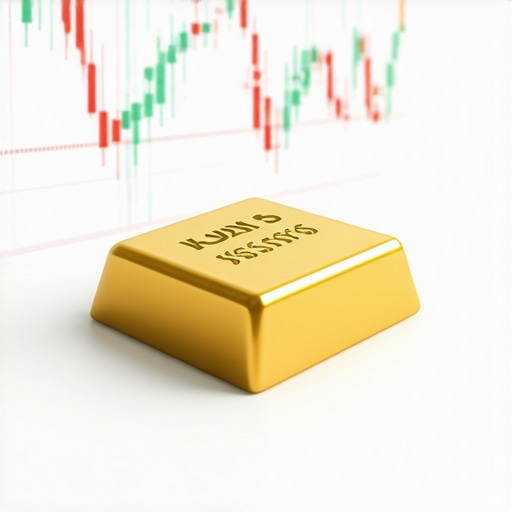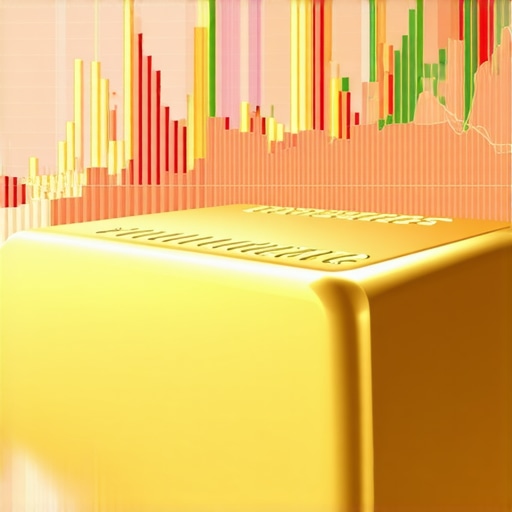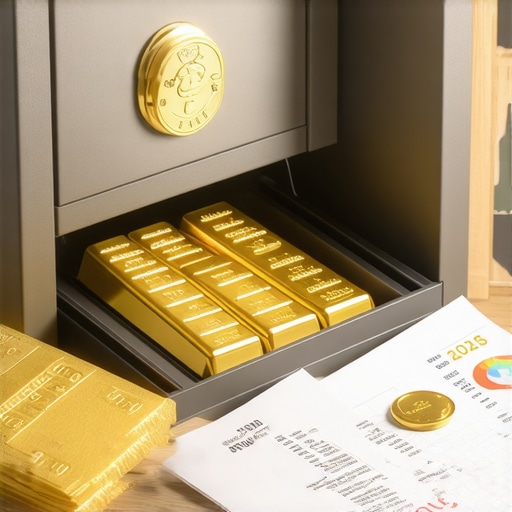Unlocking the Future: Developing a Robust Long-Term Gold Investment Plan for 2025 and Beyond
As global economic uncertainties and geopolitical shifts continue to influence market dynamics, gold remains a pivotal asset for diversification and wealth preservation. For seasoned investors and financial strategists, crafting a long-term gold investment plan requires an intricate understanding of macroeconomic trends, supply-demand mechanics, and innovative trading techniques. In this article, we explore the strategic foundations necessary for optimizing gold investments from 2025 onwards, integrating expert insights and advanced analytical frameworks.
Interpreting Macro-Economic Indicators and Gold Price Trajectories
Fundamental to any long-term strategy is the analysis of macroeconomic indicators such as inflation rates, interest rates, and currency stability. The correlation between inflation hedging and gold prices is well-documented, emphasizing the importance of monitoring fiscal policies and monetary expansions. According to recent market forecasts, gold is poised to capitalize on rising inflationary pressures, making strategic accumulation during dips a prudent approach.
Harnessing Supply-Demand Dynamics and Emerging Market Trends
Understanding supply-demand fundamentals, including central bank purchases and jewelry industry demand, is crucial for predicting future price movements. As noted in supply-demand trend reports, emerging markets in Asia and Africa are projected to drive demand growth, potentially elevating gold prices further. Investors should consider diversifying holdings across physical gold, ETFs, and mining stocks to leverage these trends effectively.
Optimizing Investment Vehicles: Physical Gold, ETFs, and Mining Stocks
Choosing the appropriate investment vehicles involves evaluating liquidity, security, and growth potential. Physical gold offers stability and tangible assets, while ETFs provide diversification and ease of trading. Mining stocks, particularly top performers in 2025, can deliver amplified returns aligned with rising prices. For detailed insights into physical gold safety practices, refer to safe buying tips.
What are the most effective strategies for balancing physical gold with financial derivatives in a long-term portfolio?
Investors should consider a layered approach, blending physical assets with futures and options to hedge against volatility. Futures analysis techniques, as discussed in futures market analysis, can enable strategic entry and exit points, maximizing overall returns while managing risk.
To further refine your strategy, explore expert analyses on market drivers and supply chain disruptions, which can significantly influence gold valuations. Engage with seasoned professionals through forums and consult reputable sources like the World Gold Council for authoritative insights.
By integrating macroeconomic assessments, supply-demand indicators, and diversified investment vehicles, a comprehensive long-term gold investment plan can be crafted to withstand market fluctuations and capitalize on emerging opportunities. As the landscape evolves, maintaining agility and leveraging advanced analytical tools will be essential for sustained wealth preservation and growth.
For a deeper dive into developing a trustworthy gold IRA and other retirement strategies, visit trusted retirement planning resources.
Integrating Quantitative Models and Market Sentiment in Gold Investment Planning
In the quest for superior long-term returns, savvy investors increasingly turn to quantitative analysis and sentiment metrics to refine their gold investment strategies. These tools enable a data-driven approach, allowing investors to anticipate price movements with greater precision. For instance, machine learning models can analyze vast datasets, including macroeconomic indicators, geopolitical events, and market sentiment, to identify emerging trends before they become apparent. According to a recent report by the Gold Market Analysis, integrating these advanced techniques can significantly enhance decision-making, especially in volatile environments.
Challenging Conventional Wisdom: Is Gold Truly a Safe Haven in 2025?
Many investors assume gold will always serve as a safe haven during economic downturns, but emerging data suggests a more nuanced reality. While gold historically offers protection against inflation and currency devaluation, its performance can be influenced by factors such as technological shifts in mining, regulatory changes, and global economic policies. Experts like those at the World Gold Council emphasize that diversifying across physical gold, ETFs, and mining stocks remains crucial for risk mitigation. Understanding these complexities helps investors avoid over-reliance on assumptions and develop resilient portfolios that adapt to changing conditions.
What are the most innovative tools for refining gold investment tactics in 2025?
Investors should explore emerging technological tools such as blockchain for provenance verification, AI-driven market simulations, and real-time supply-demand analytics to enhance their investment decision process. These innovations provide transparency, predictive power, and agility. For example, blockchain technology ensures the authenticity of physical gold holdings, reducing fraud risk, while AI models can simulate market scenarios to evaluate potential outcomes. To stay ahead, consider leveraging insights from strategic trading techniques that incorporate these cutting-edge tools.
Engaging with expert communities through forums and subscribing to industry reports can further deepen your understanding of how technological advancements are shaping gold markets. Additionally, developing a diversified approach that includes physical gold, ETFs, and mining stocks—as discussed in diversify your portfolio—ensures resilience against unforeseen shifts.
Are you ready to incorporate these innovative strategies into your long-term gold investment plan? Share your thoughts or ask questions below—your insights could spark a valuable discussion among fellow investors.
Harnessing the Power of Derivatives: Sophisticated Hedging Techniques for Gold Investors
In the complex landscape of gold investing, sophisticated hedging strategies utilizing derivatives can significantly mitigate risk and enhance portfolio stability. Investors proficient in options and futures markets can craft tailored approaches, such as collar strategies or calendar spreads, to protect gains or capitalize on anticipated price movements. According to research by the CME Group, these instruments offer flexible risk management tools, allowing investors to lock in prices or hedge against adverse market shifts effectively.
What are the nuances of implementing a dynamic hedge in volatile gold markets?
Dynamic hedging involves actively adjusting hedge positions in response to market movements, requiring a keen understanding of delta and gamma sensitivities. This approach demands real-time data analysis and rapid execution, often supported by algorithmic trading systems. Incorporating machine learning models for predictive analytics, as suggested by QuantInsti, can refine these adjustments and optimize hedge ratios, providing a competitive edge in turbulent markets.
Engaging with professional quantitative analysts and utilizing advanced risk management software are crucial steps to implementing these strategies successfully. Such approaches can turn market unpredictability into a manageable risk, allowing long-term investors to preserve capital while positioning for growth.
Leveraging Blockchain and Digital Asset Technologies for Gold Provenance and Security
The integration of blockchain technology into gold investment processes marks a revolutionary step toward transparency, security, and authenticity verification. Blockchain’s immutable ledger ensures the provenance of physical gold, reducing fraud risks and simplifying audit trails for investors. Companies like Goldex are pioneering solutions that link physical assets with digital tokens, enabling seamless transfer and fractional ownership.
Furthermore, smart contracts facilitate automated compliance and settlement processes, reducing transaction costs and settlement times. This technological shift not only enhances investor confidence but also opens new avenues for fractional investing and liquidity management, crucial for diversified long-term portfolios.

How might blockchain-driven provenance impact global gold markets’ transparency and regulation?
Enhanced transparency can lead to more efficient markets, reduced illicit trade, and better regulatory oversight, aligning with the directives of the International Monetary Fund. As blockchain adoption grows, investors should stay informed about evolving standards and interoperability protocols to maximize benefits and ensure compliance across jurisdictions.
If you’re keen to explore how these cutting-edge tools can be integrated into your gold investment strategy, consulting with industry experts and participating in specialized seminars is highly recommended. Continuous education and technological adoption are key to maintaining an edge in the rapidly evolving landscape of precious metals investing.
Harnessing Quantum Computing and AI for Next-Generation Gold Market Predictions
As technological advancements accelerate, integrating quantum computing and artificial intelligence into gold investment strategies offers unprecedented analytical precision. Quantum algorithms can process vast datasets—encompassing macroeconomic indicators, geopolitical risks, and market sentiment—to generate highly accurate predictive models. According to a recent publication by the Quantum Tech News, these innovations are poised to redefine how investors anticipate price movements and optimize portfolio allocations.
How Can Deep Learning Improve Long-Term Gold Price Forecasting?
Deep learning models, especially recurrent neural networks (RNNs) and transformers, excel at capturing complex temporal patterns within financial data. By analyzing multi-year trends, news sentiment, and economic reports, these models can forecast future gold prices with a higher degree of confidence than traditional methods. Financial institutions are increasingly adopting these tools, as highlighted in Fintech Magazine, to refine entry and exit strategies, reduce volatility exposure, and enhance risk-adjusted returns.
What are the practical applications of integrating AI-driven forecasts into a diversified gold portfolio?
Investors can leverage AI-generated insights to time market entries during dips, adjust holdings dynamically, and hedge against unforeseen shocks. Combining these forecasts with real-time supply chain analytics and geopolitical risk assessments provides a holistic view—enabling proactive adjustments rather than reactive responses. Engaging with expert systems and advanced analytics platforms can facilitate this integration, ultimately leading to more resilient and profitable investment strategies.
To maximize the benefits, consider subscribing to specialized AI-driven market analysis services and collaborating with quantitative analysts skilled in machine learning techniques. These approaches not only improve forecast accuracy but also foster a nuanced understanding of evolving market drivers, ensuring your long-term gold strategy remains robust amidst global uncertainties.
Emerging Regulatory Frameworks and Their Impact on Digital Gold Assets
The rapid integration of blockchain and digital tokens into gold investments necessitates awareness of emerging regulations. Regulatory clarity, especially concerning digital asset classification and cross-border compliance, can significantly influence market accessibility and security standards. According to the World Bank, proactive engagement with regulatory developments is essential for safeguarding assets and maintaining market integrity.
Investors should monitor international policy shifts and participate in industry forums to stay ahead of regulatory trends. Implementing compliance frameworks aligned with evolving standards not only mitigates legal risks but also enhances investor confidence—crucial for long-term strategic planning in the digital age.

How might regulatory developments shape the future liquidity and valuation of digital gold assets?
Enhanced regulation can foster market stability, attract institutional investors, and facilitate global adoption of digital gold tokens. Conversely, overly restrictive policies may limit liquidity and hinder innovation. Staying informed through authoritative sources, such as the Fintech Regulation Consortium, ensures investors can adapt swiftly to policy changes and capitalize on emerging opportunities.
Are you prepared to integrate these technological and regulatory insights into your long-term gold investment plan? Engage with industry experts, participate in advanced seminars, and continually refine your approach to navigate the complexities of modern precious metals investing effectively.
Expert Insights & Advanced Considerations
1. Integration of Quantitative Models Enhances Predictive Accuracy
Leveraging machine learning and AI-driven analytics allows investors to anticipate market shifts with unprecedented precision, enabling proactive strategy adjustments.
2. Blockchain Provenance Boosts Market Transparency and Security
Implementing blockchain technology ensures the authenticity and traceability of physical gold assets, reducing fraud and enhancing investor confidence in long-term holdings.
3. Dynamic Hedging Methods Mitigate Volatility Risks
Adopting sophisticated options and futures strategies, including real-time adjustments supported by algorithmic systems, can effectively hedge against market fluctuations.
4. Regulatory Evolutions Will Shape Digital Gold Markets
Staying informed about international regulatory developments is crucial, as clearer standards will foster market stability and drive institutional participation.
5. Technological Innovations Open New Investment Avenues
Exploring blockchain, AI, and quantum computing tools offers a competitive edge, providing transparency, predictive power, and agility in portfolio management.
Curated Expert Resources
- World Gold Council: The foremost authority on gold market insights, offering comprehensive reports on supply-demand dynamics and regulatory trends.
- QuantInsti: Leading platform for algorithmic trading and machine learning applications tailored to precious metals markets.
- IMF Official Publications: Authoritative analyses on international monetary policies and their impact on gold and digital assets.
- Goldex Blockchain Solutions: Innovators in gold provenance verification through blockchain, setting industry standards for transparency.
- Fintech Magazine: Publications covering cutting-edge technological developments shaping future gold investment landscapes.
Final Expert Perspective
In the realm of long-term gold investment, integrating advanced analytical tools, technological innovations, and a keen understanding of evolving regulations is indispensable. Developing a resilient, data-driven strategy for 2025 and beyond demands not only macroeconomic awareness but also mastery of emerging digital and blockchain technologies that redefine transparency and security. As an expert in the field, I encourage investors to continually refine their approach, engage with authoritative resources, and embrace innovation—because in the complex world of gold investing, staying ahead is synonymous with sustained wealth preservation and growth. Engage with industry peers, contribute your insights, and explore the latest research to elevate your strategic planning to new heights.











This article provides a comprehensive overview of the many facets involved in developing a long-term gold investment strategy for 2025 and beyond. I particularly appreciate the emphasis on integrating technological tools like blockchain and AI, which are revolutionizing transparency and predictive analytics in precious metals. In my experience, staying informed about regulation changes has also been crucial, especially with the rapid growth of digital assets related to gold. I do wonder, though, how investors can balance embracing innovative tech with the risks of regulatory uncertainty? Have you seen effective approaches to mitigate regulatory risks while integrating these advanced tools? Overall, this piece does a great job highlighting the importance of a multi-layered, adaptable approach in today’s evolving market landscape.